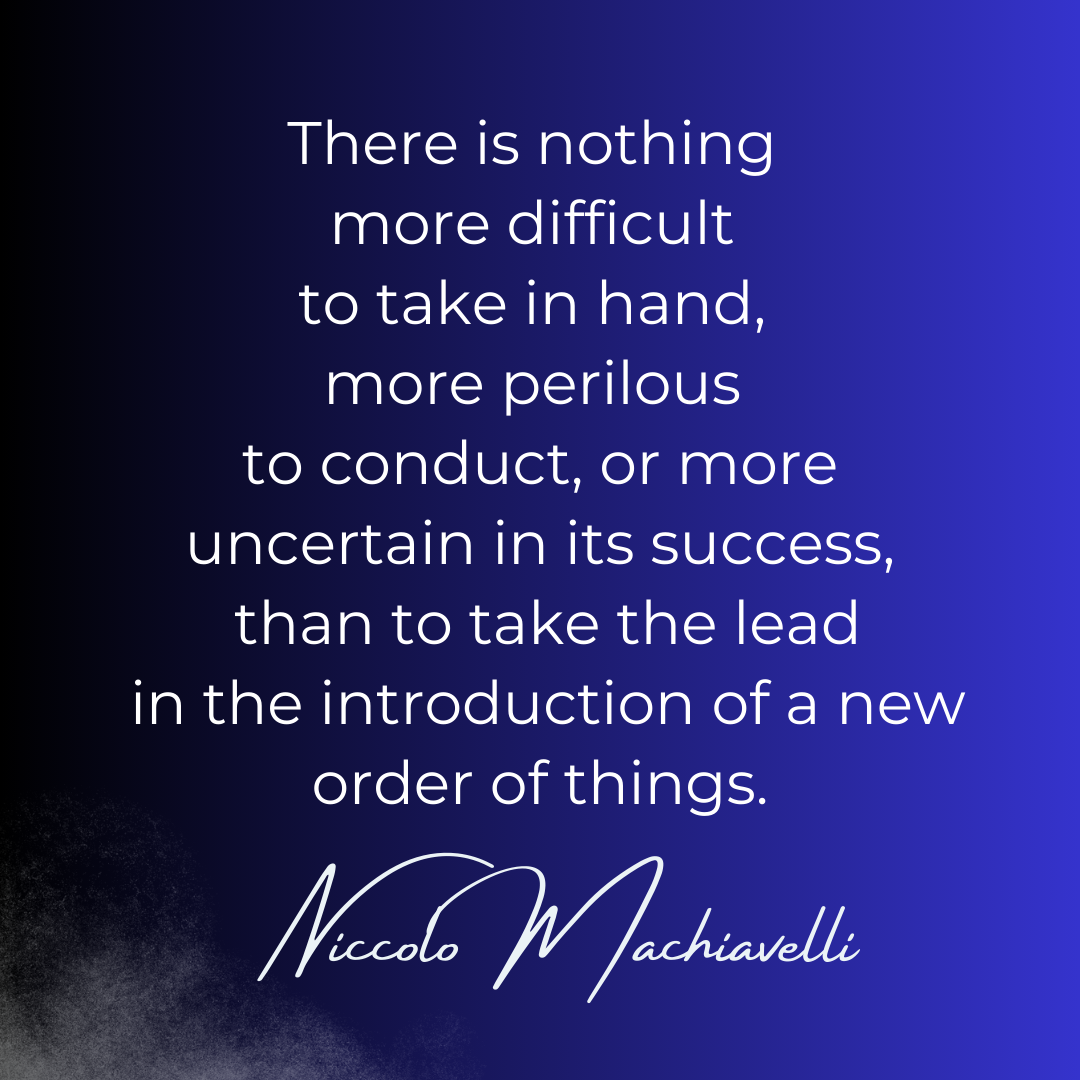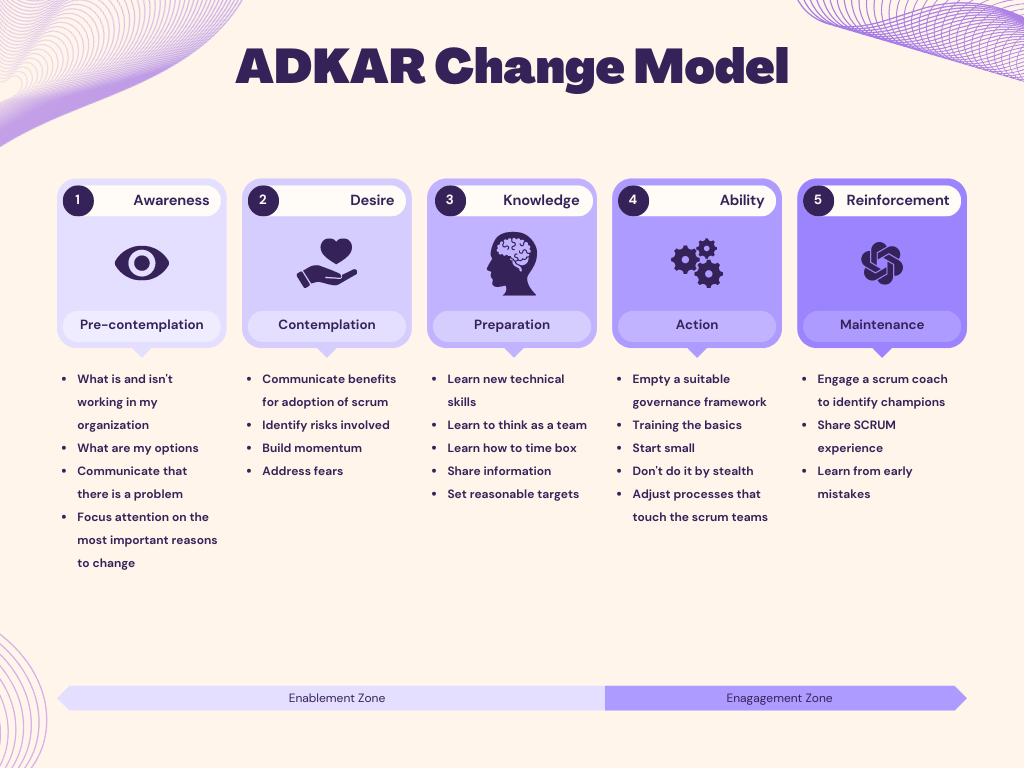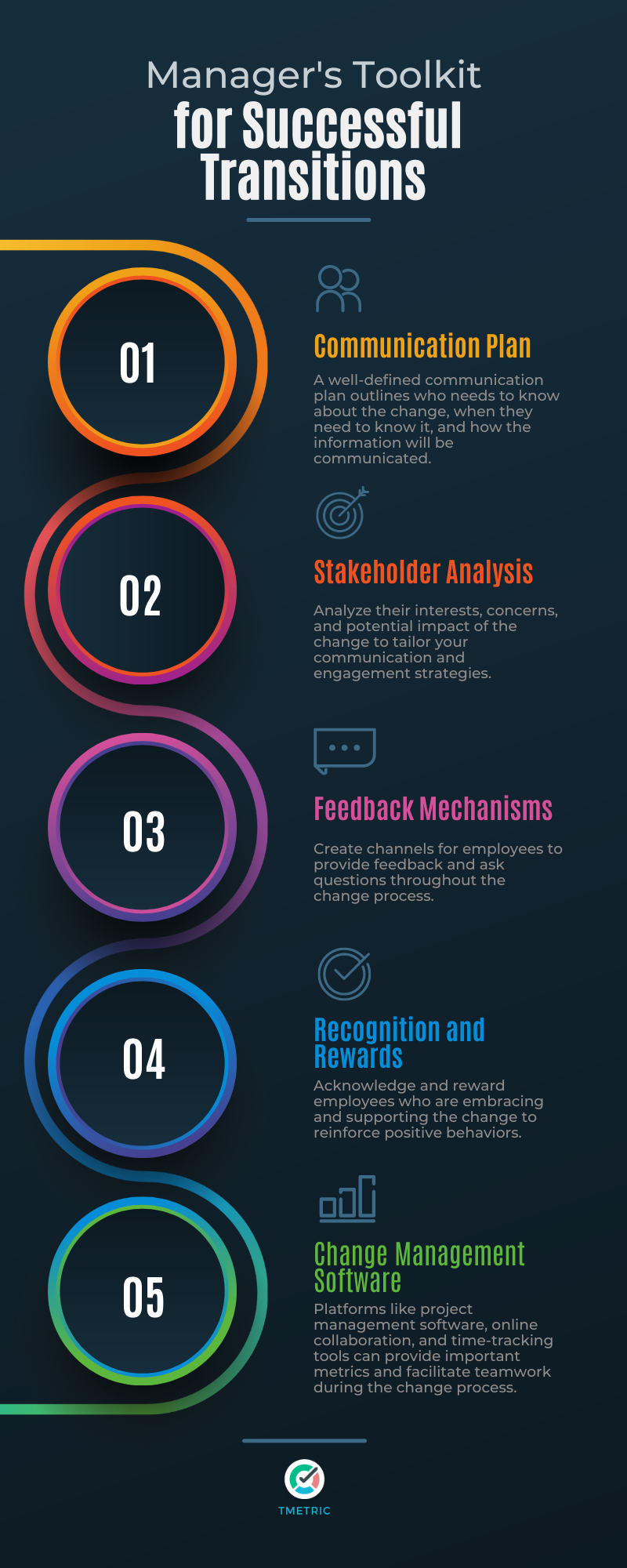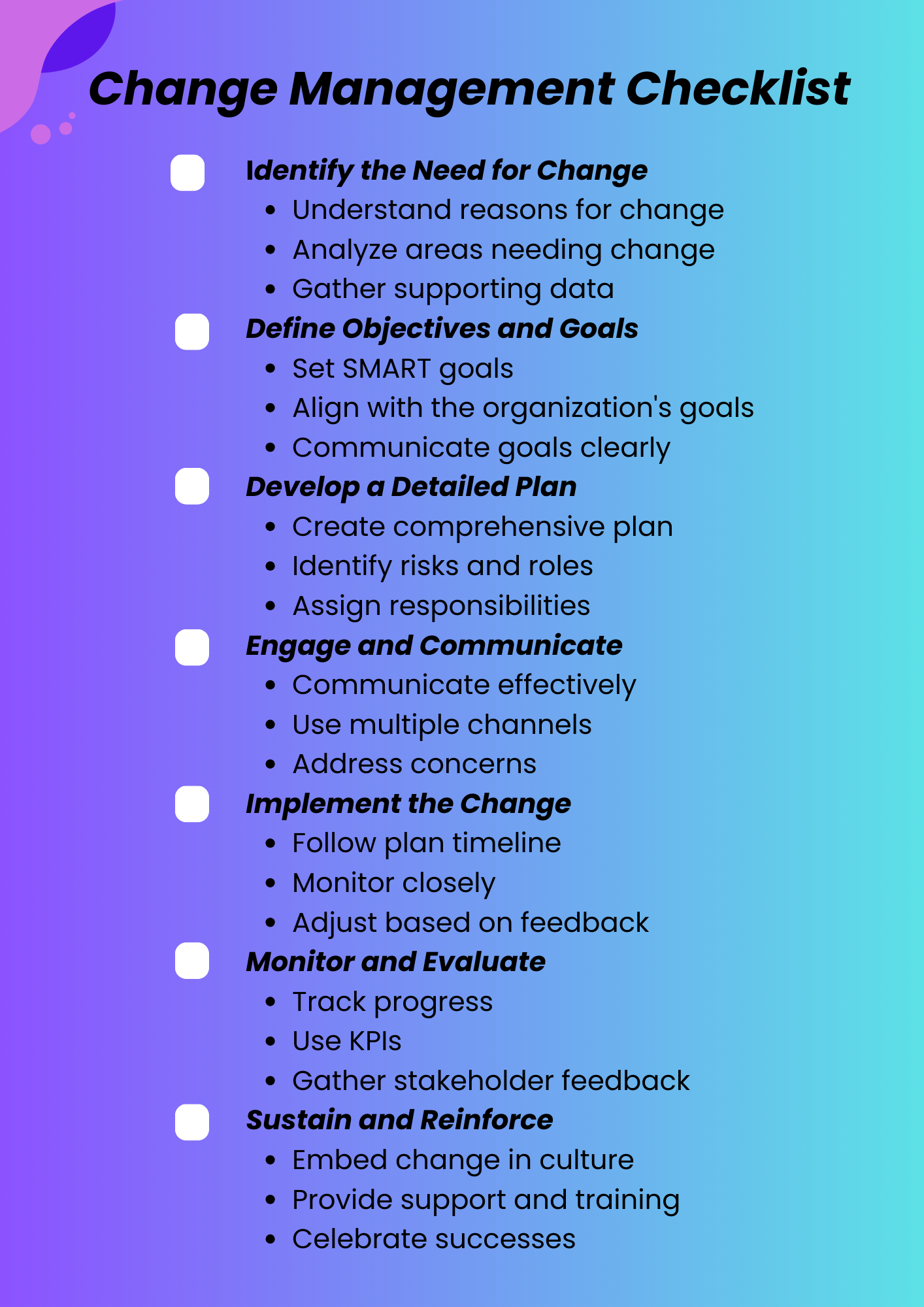How to Master Change Management Process in 7 Steps
Master the change management process in 7 simple steps with this comprehensive guide. Learn definitions, models, and tips to implement, and sustain organizational change.

Change management is a well-established approach in the business world, dating back to the 1940s.
Experts in Change Management: Insights and Influence
- Kurt Lewin: A German-American psychologist credited with coining the term "change management". He developed the Unfreeze-Change-Refreeze model, a simple framework for managing change through preparing for change, implementing it, and solidifying it.
- John Kotter: A Harvard Business School professor who popularized the term "change management" and developed a widely-used eight-step process for leading change, which emphasizes creating a sense of urgency, forming a powerful coalition, and creating a clear vision.
- Don James: Created the Perigon Method®, a business mapping methodology that provides a detailed understanding of business processes and facilitates organization ownership and accountability for change.
- Daniel Goleman: Pioneered the field of emotional intelligence and its importance in change management, highlighting self-awareness, self-management, and empathy as key leadership qualities.
- Jim Hemerling: Emphasizes putting people first and creating an empowering and energizing environment for change, including connecting change to purpose, investing in talent, and fostering continuous learning.
- Jeff Hiatt: Founded Prosci and developed the ADKAR model to address employee resistance to change, focusing on awareness, desire, knowledge, ability, and reinforcement.

What is a Change Management Process?
The definition of change management process implies a systematic process of:
- effecting change
- controlling change
- helping people adapt to change.
The transformations usually touch upon the three key areas.
- Organizational goals: This includes changes to the overall vision, mission, and strategic objectives of the organization.
- Internal business processes: This involves modifying or optimizing the ways in which work is done within the organization.
- Technologies: This encompasses the adoption of new technologies or the modification of existing ones.

Real-World Examples of Change Management
Implementing New Technologies or Processes
- Introducing new software, hardware, or systems can disrupt existing workflows and require employees to learn new skills. Change management helps ensure smooth adoption and minimize disruption.
Restructuring or Mergers
- Organizational changes like mergers, acquisitions, or departmental restructuring can be complex and create employee uncertainty. Change management helps manage the transition and address concerns.
Cultural Shifts
- Changing an organization's culture requires a deliberate and structured approach. Change management helps align employee behaviors and values with the desired culture.
Responding to External Pressures
- Market changes, new regulations, or economic shifts can necessitate organizational adjustments. Change management helps organizations adapt effectively and maintain competitiveness.
Improving Performance
- Organizations can implement initiatives or processes to improve efficiency or effectiveness without major shifts. Change management helps ensure these initiatives are adopted and sustained.
Additionally, change management is beneficial for:
- Large-scale projects: Any significant undertaking involving multiple teams or departments can benefit from a structured approach to manage the change and ensure successful implementation.
- High-risk initiatives: Change management helps mitigate risks associated with significant changes by addressing potential issues and ensuring proper planning and communication.
- Employee engagement: By involving employees in the change process and addressing their concerns, change management can foster engagement and buy-in, leading to smoother implementation and better results.
The Main Change Management Models
Kübler-Ross Change Curve Model
This model depicts emotional responses that employees experience varying reactions to the change. It progresses through five stages: denial, anger, bargaining, depression, and acceptance.
To address probable concerns proactively, leaders must:
- provide support
- reinforce positive behaviors
- manage resistors
- monitor progress closely to minimize disruption.

ADKAR Model
This model focuses on individual readiness for change. It includes five phases:
- Awareness
- Desire
- Knowledge
- Ability
- Reinforcement.


Comfort Zone Model
This model illustrates how people prefer familiarity and stability but can grow by stepping outside their comfort zone.
This eight-step model focuses on creating a sense of urgency, building a guiding coalition, forming a vision for change, and communicating the vision.
Kübler-Ross Change Curve Model
This model illustrates the development of unconscious incompetence to unconscious competence through conscious effort and learning.
This model emphasizes the relationship between activities, resources, and desired outcomes.
Dreyfus Model of Skill Acquisition
This model describes skill development through five stages: novice, advanced beginner, competent, proficient, and expert.
Mindset: The Will/Want Principle
This model focuses on developing a “will” or “want to” mentality for change.
OSCM (Omission - Substitution Algorithm of Change)
It implies identifying and eliminating unproductive habits or routines and integrating new practices that promote desired behaviors.
Omitting destructive behavior and substituting old outlived practices with more productive ones bears guaranteed results in behavior change management.
Change Management Process Examples
Procter & Gamble (P&G)
Strategy: Integrated Change Management
- Approach: P&G implemented an integrated change management strategy to streamline their supply chain operations. They focused on aligning their change initiatives with their business processes and culture.
- Outcome: The company achieved significant cost savings and improved efficiency across their supply chain.
Strategy: Continuous Improvement and Innovation
- Approach: Google fosters a culture of continuous improvement and innovation. They encourage employees to experiment with new ideas and provide the necessary support to implement changes.
- Outcome: This strategy has led to numerous successful product launches and improvements, maintaining Google’s position as a leader in the tech industry.
General Electric (GE)
Strategy: Six Sigma Methodology
- Approach: GE adopted the Six Sigma methodology to drive process improvements and operational excellence. They trained employees in Six Sigma principles and integrated these practices into their daily operations.
- Outcome: GE achieved substantial improvements in quality, efficiency, and customer satisfaction, leading to increased profitability.
Microsoft
Strategy: Cultural Transformation
- Approach: Under CEO Satya Nadella, Microsoft underwent a cultural transformation to become more collaborative and customer-focused. They emphasized growth mindset, empathy, and inclusivity.
- Outcome: This cultural shift revitalized Microsoft, leading to increased innovation, employee engagement, and market success.
Kotter International
Strategy: 8-Step Change Model
- Approach: Kotter International uses John Kotter’s 8-Step Change Model to guide organizations through change. The steps include creating a sense of urgency, forming a powerful coalition, and generating short-term wins.
- Outcome: Organizations using this model have successfully navigated complex changes, achieving sustained improvements and growth.
IBM
Strategy: Agile Transformation
- Approach: IBM adopted agile methodologies to enhance their software development processes. They focused on iterative development, cross-functional teams, and customer feedback.
- Outcome: The agile transformation led to faster delivery of high-quality software products and improved customer satisfaction.
Amazon
Strategy: Customer-Centric Innovation
- Approach: Amazon’s change management strategy revolves around customer-centric innovation. They continuously gather customer feedback and use it to drive changes in their products and services.
- Outcome: This approach has enabled Amazon to stay ahead of competitors and maintain high levels of customer loyalty.
Netflix
Strategy: Data-Driven Decision Making
- Approach: Netflix uses data analytics to guide their change management decisions. They analyze viewer data to make informed changes to their content offerings and user experience.
- Outcome: This data-driven approach has helped Netflix to continuously adapt to market trends and customer preferences, leading to sustained growth and success.
7 Steps in Building Change Management Strategies
To navigate the transformation successfully, let's explore a step-by-step approach to effective change management.
According to a recent report by McKinsey,
Achieving real transformational change calls for converting ambitious ideas into measurable outcomes with lasting impact.

Planning
- Identify the Need for Change: Understand why the change is necessary and conduct a thorough analysis to identify the areas that require change.
- Develop a Plan: Set specific objectives, define the scope, and determine the resources required. Create a comprehensive change management plan that outlines the steps, resources, and timelines.
- Stakeholder Analysis: Identify all stakeholders affected by the change and assess their influence, interest, and potential impact on the change process.
Communication
- Communication Planning: Develop a communication plan to keep stakeholders informed. Use various channels (emails, meetings, newsletters) to disseminate information.
- Transparent Communication: Communicate frequently and openly to build trust. Keep stakeholders informed about the change, its purpose, progress, and potential impact.
- Engage Executives: Mobilize active and visible executive sponsorship. Engage executives who actively champion the change and visibly demonstrate their commitment.
Training and Support
- Training Programs: Provide training programs to equip employees with the necessary skills and knowledge. Offer workshops, seminars, and online courses.
- Support Mechanisms: Provide ongoing support to help employees adapt to the new processes or technologies. This can include one-on-one coaching and dedicated support resources.
- Engage People Managers: Equip managers with the necessary tools and training to lead their teams through the change. Their role in guiding employees is critical.
Implementation
- Execute the Plan: Implement the change according to the defined timeline. Coordinate activities, manage resources, and ensure that the change is carried out smoothly. To initiate the change, it is crucial that leaders establish clear objectives, assess risks, develop communication strategies, identify necessary resources, and design measures to evaluate progress.
- Pilot Testing: Implement the change on a small scale before a full rollout. Gather feedback and make necessary adjustments.
- Engage Front-line Employees: Involve employees at all levels. Their insights and buy-in are essential for successful implementation. Regularly communicate with them and address their concerns.
Monitoring and Evaluation
- Track Progress: Continuously monitor the progress of the change initiative. Use key performance indicators (KPIs) and metrics to measure success.

- Feedback Mechanisms: Establish channels for continuous feedback from employees and stakeholders. Use surveys, suggestion boxes, and regular check-ins.
- Evaluate Effectiveness: Collect feedback, identify any issues, and make necessary adjustments to ensure the change is effective.
Sustainability
- Embed the Change: Once initial adaptation occurs, emphasis shifts towards reinforcing new practices and embedding them within the organization's culture. Continuous assessment ensures sustainability while celebrating successes encourages ongoing improvement. It facilitates smoother organizational change adoption, fostering long-term growth and development.
- Celebrate Successes: Recognize and celebrate milestones and successes. Acknowledge contributions and efforts of individuals and teams to reinforce the change.
- Change Readiness Assessment: Evaluate the organization’s readiness for change. Conduct surveys and interviews to gauge employee sentiment and preparedness.
Structured Approach and Resource Allocation
- Apply a Structured Approach: Use established frameworks or methodologies to guide the change process. A systematic approach ensures consistency and effectiveness.

- Align with Project Management: Engage and integrate with project management efforts. Coordination between change management and project management enhances overall project success.
- Dedicate Resources: Allocate resources specifically for change management activities. Having dedicated personnel ensures focused efforts and better results.
Change Management Process Checklist
This checklist can help ensure that all critical aspects of the change management process are covered and managed effectively.

🎁Bonus: Major Change Management Template by BEM
The Change Management Software Solutions
Choosing the right software depends on your specific needs and budget. Consider several factors listed below.
- Features: Does the software offer the functionalities you need for your change initiative?
- Scalability: Can the software accommodate your organization's size and future growth?
- Ease of use: Is the software user-friendly for both managers and employees?
- Integration: Does the software integrate with other tools you use in your organization?
TMetric for Accuracy of Metrics
TMetric serves as a strategic facilitator, streamlining the change management process through its multifaceted functionalities.
Time Tracking and Resource Management
- Identify how much time is spent on planning, communication, training, and implementation.
- Ensure team members are not overloaded during the change process and adjust resources as needed.
- Use historical data to estimate the time needed for future change initiatives.
Project Management and Collaboration
- Break down the process into smaller, actionable steps and name assignees.
- Monitor the progress of tasks and ensure they are completed on time.
Reporting and Analytics
- It offers reports to track change history, identify trends, and measure the effectiveness of your change management process.
- Track key metrics like time to completion, cost, and employee satisfaction to assess the success of the change.
Improved Transparency and Accountability
- Clarify each team member's contributions to promote transparency and accountability
- Identify and address areas where the change process is lagging to improve efficiency.
The Role in Change Management: TMetric is a helpful tool in the organizational change management process that delivers insights into time spent, resource allocation, and project progress. This data can be used to make informed decisions, optimize the change process, and ensure successful implementation.
Wrike for Effective Task Monitoring
Wrike empowers your team to navigate the change management process flow with its intuitive features.
Clear Visibility
- Wrike visual workspace keeps everyone on the same page. Customizable dashboards provide a real-time snapshot of projects, tasks, timelines, and dependencies.
Standardized Requests & Approvals
- Wrike streamlines the request process with custom forms. These requests flow through predefined approval workflows, ensuring proper oversight before implementation.
Data-Driven Decisions
- Measure the impact of your changes and optimize future efforts using Wrike robust reporting. Customizable dashboards, KPIs, and visualizations allow managers to evaluate the effectiveness of changes and demonstrate the return on investment (ROI).
The Role in Change Management: Wrike's visual workspace, standardized request forms, insightful reporting, and robust integrations make it a valuable tool for managing and optimizing change within your organization.
Freshservice for Streamlined Workflows
It offers a robust change management module as part of its IT service management (ITSM) platform.
Streamlined Workflow
- Freshservice simplifies the management of change process. You can submit change requests directly from issue tickets, and the system guides users through approval workflows.
Impact Assessment
- Freshservice allows you to define the reason for a change and assess its potential impact. This helps decision-makers weigh the risks and benefits before approving.
Collaboration Features
- Stakeholders can collaborate on change requests through comments and attachments. Integration with popular tools like MS Teams and Slack further enhances communication.
Approval Workflows
- Freshservice lets you configure multi-level approval workflows with Change Advisory Board (CAB) integration. This ensures proper oversight for high-impact changes.
Rollback Planning
- The system facilitates creating rollback plans, a crucial step for minimizing disruption in case of unforeseen issues.
The Role in Change Management: Freshservice is a strong contender for organizations seeking a user-friendly solution for the change management process. Its core functionalities are well-suited for managing IT infrastructure changes and streamlining the approval process.



